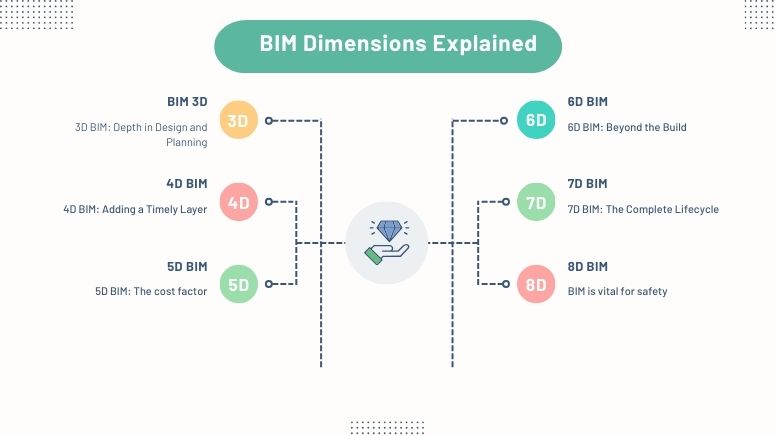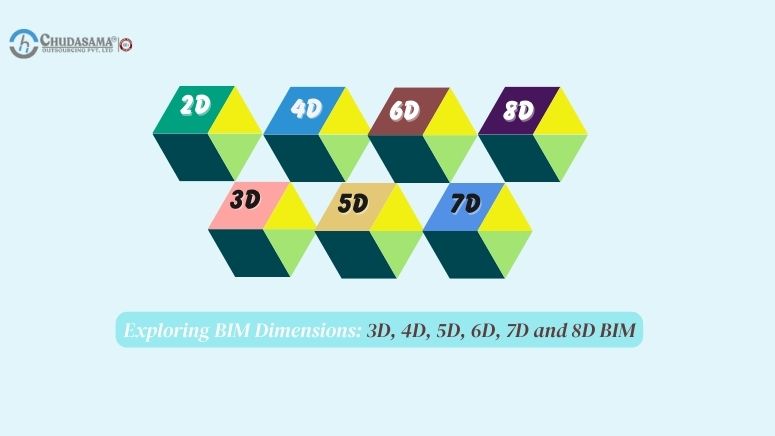As the construction sector races against time with fast-paced, dynamic changes, BIM dimensions, Building Information Modeling (BIM) has been propelled as one of the building blocks leading to a transformation that will be a different world as we know it now.
The substance of BIM is achieved through dimensions – not validly said in the case of dimensions of physical constructs, but its framework that integrates and processes complications.
Once these connections are established, there is no going back and keeping abreast of this knowledge framework is crucial for any construction professional. Today, innovation and efficiency are always the focus when facing economic competition.
If you are an energetic BIM advocate, then the” BIM dimensions” is a word you have heard or read dozens of times. Watching these two space flicks might make you look forward to mind-bending space travel and other worlds like in The Interstellar or Multiverse, but do not expect to be disappointed when you see the real version as the actual BIM dimensions have not been measured!
BIM consists of several attributes denoting the data-holding building model that will facilitate the stages of the project. Now, we will describe BIM’s main elements and continue with the relations of dimensions and BIM levels.
It’s not ordinary to call technology “revolutionary,” but Building information modeling (BIM) has made a good name for it over the last 2-3 decades.
Implementing BIM involves a strategy to lead and manage information on a built asset. It is a hybrid of multiple sources of information organized in a governed and standardized manner, which is then used to create an intelligent asset model throughout its lifecycle.
The BIM reality can be complex because it is complicated when we do not begin to introduce the BIM dimensions of each level of BIM construction: 3D, 4D, 5D, 6D, 7D, and 8D.
If you are wondering about the A-Z of BIM, this guidebook puts everything in one place. Finally, we will clarify BIM’s mysteries so you don’t have to look at our explanation in an alien language. We will also provide the expertise to make use of the technology properly.
What’s a BIM dimension?
BIM (Building Information Modeling) dimensions are not only an add-on but a techie touch that eases the participants to view the project at different stages.
They reveal various designs – from a simple 2D icon to a highly complex 3D model with dimensions depicted. BIM development has gone beyond the 3D scope. It covers 4D (time scheduling), 5D (cost overruns), 6D (lifecycle information), 7D (facility management data), and 8D BIM ( vital for safety).
This generally encompasses project comprehension and management. The mentioned aspects play an essential role at each stage of the building progression, from the planning stage to management and operation maintenance.
How many dimensions are involved in BIM? And what is the hierarchical structure that defines them?
BIM dimensions start from 2D to 8D, with each layer representing more information and utility, moving from the design drafts to the building management.
The version of BIM, which is 2D, is the simplest one as it also includes the drawings as plans in flat 2D view. Being the simplest and original form, 2D BIM depicts a scheme that gives a picture to be used for measurement for the whole project.
3D BIM is an advanced version of traditional BIM, where the third dimension of depth, height, and width is added instead of the previous images composed of simple distances to create an accurate scale of spatial dimensions, transforming old images into real-life visuals.
It sparks stakeholders to interpret and communicate with the design, which involves them deeply in the decision-making processes, hindering defects from emerging.
This position is occupied by the 4D BIM system, which aims to add time by involving the project schedules in the model. This scenario helps avoid misunderstandings and complications related to the building processes, which, in turn, provides better management of the entire operation.
When 5D BIM is used, the critical question is how to keep the cost at a functional level. This report contains the budgeting data connected to the model, making it straightforward to get complete cost analysis and micro-management within the project life cycle.
The String of 6D BIM, commonly called for the environment, integrates measurements of down energy consumption and environmentally friendly metrics in the model for supporting green building elements.
Additionally, operation and maintenance information forms the 7th category of 7D BIM. On this level, the building authorities will be provided with documentation, which includes separate asset inventory, warranty, and maintenance examinations containing all necessary information for the building’s further management, thus ensuring its efficiency and sustainability for long-term use.
These five dimensions must be considered because only then can the total capacity of BIM be utilized, and the industry can work towards more precision, higher efficiency, and reduced impact during construction projects.
BIM Dimensions Explained

2D BIM
The best approach is starting with the 2D dimension, often deemed the most known among architects and designers. It is used to represent the information about points on an x and y axis, which implies that the drawing will have a flat or not solid form that will not give it any depth. A 2D floor plan, sections and elevations are examples produced during the drawing phase.
3D BIM: Depth in Design and Planning
When you consider BIM, 3D is probably the first to flash into your mind. Here, the models going beyond the non-existent entities become special and start the construction of depth and viewpoint in the design and planning.
Stakeholders could foresee the building in reality as it is with 3D BIM revealing the components clashing and design issues before the site workers would even see those.
The Advantages of 3D BIM
- Increase in visual communication skill set.
- The design experimentation and further iteration of such modality.
- Integration and conflict reduction are the critical aspects of improved collaboration.
Case Study: Enhancing Architectural Designs
Leading designers at an innovative design firm incorporated 3D BIM while creating elaborate facades that integrated shape and utility. The project won an award and met all of the strict strength and performance requirements.
4D BIM: Adding a Timely Layer
Spatially, the next dimension of the BIM adds the crucial time component by developing schedules and sequencing activities into 3D models. It is known as 4D BIM and allows the project teams to visualize how the construction moves over time. In this case, the system allows them to identify bottlenecks and streamline processes for increased success.
Time is so crucial in Building Information Modeling (BIM)
- Accurate and detailed cost forecasting
- Efficient change management and impact analysis
- Continuous alignment of cost and schedule
Real-life Application: Playing with time coordinates in the development process of architecture.
A construction organization operating on a global level decided to take the use of 4D-BIM to a new level to align the design implementation with its construction schedule and accomplish significant savings in terms of build time; 15% was saved, which is quite a bit.
5D BIM: The cost factor
Including cost as a parameter, the BIM model (fourth dimension) guarantees its fifth dimension. The 5D BIM blends cost information into the 3D model, leading to cost estimation and real-time tracking and management of costs.
Transparency in budget allows you to avoid budget overruns and manage the project’s financial planning according to its progress.
Incorporating Costs into BIM
So, effective and precise spend predictions.
- Accurate and detailed cost forecasting
- Efficient change management and impact analysis
- Continuous alignment of cost and schedule
Implementation Insights: Cost-Effectiveness in the Project Solutions
For a developer of infrastructure, the cost-controlling capabilities of 5d BIM, which made it possible to save the plan of the high-risk project and complete it under the stipulated budget, means a lot. Each building element is embodied in the dynamic model, allowing one to foresee and prevent cost overruns.
6D BIM: Beyond the Build
The subject comes into the picture of sustainability, efficient operation, and BIM’s sixth dimension. 6D BIM provides users with the relevant data for Green building design and the regulations for sustainable construction practices when the project is over.
This is a feature of 6D BIM that I have gained the most use from, and it is only with this technology that AS can identify and optimize energy consumption and flow without having to do everything or anyone on their own.
- LCA helps us in the decision-making process of selecting eco-friendly options throughout the product’s lifetime.
- The possible performance of a building through preventive maintenance
- Environmental assessment and certification are effective long-term strategies.
Pioneering Eco-Friendly Constructs
An intended 6D BIM engineer ultimately concentrated on LEED-certified high-rise buildings, thus enduring long-term compliance with green standards and reducing carbon lot.
7D BIM: The Complete Lifecycle
Building Information Modeling Is the most impactful dimension. 7D increases the model’s validity by expanding the model’s life from design to demolition. This approach, which considers demolition planning, material recycling and end-of-life considerations, is full-spectrum.
BIM That Travels Full Circle
- Efficient deconstruction and recovery planning
- Material and component traceability
- Streamlined handover and operational readiness
A Sustainable Demolition Strategy
A 7D BIM was implemented by a demolition team for the dismantling of an older building, which led to the recovery of materials for reuse and recycling and reduced waste.
8D BIM
8D BIM is vital for safety while building by simply embedding the safety information in the model at the design stage. This BIM technique can also be employed side by side with other advanced technologies like VR (virtual reality) to observe the modeled location and envision any possible dangers onsite.
Fostering Community Engagement through 8D BIM
- Proactive assessment of environmental and social impact
- Enhanced stakeholder communication and involvement
- Advanced planning for public amenities and infrastructure
Transformative Community Projects
One innovative application of 8D BIM in an urban area is the improvement project designed with the incorporation of public spaces, green areas, and amenities that strengthened residents’ ties to the neighborhood and increased the quality of their lives.
Utilizing Building Information Modeling (BIM) to Achieve Project Success
BIM is gaining popularity among construction professionals looking for methodologies to harness its entire potential. Different dimensions that are a part of BIM can be fully exploited through consistent integration throughout all project phases, from initiation to completion.
Integrating All Dimensions for a Holistic Approach
In a nutshell, wisely utilizing a model’s potential requires not only impeccable skills in a single layer – it is more about coordinated actions at every level. It is about building the communication founding blocks, using interoperable software systems, and facilitating the information exchange among the organization’s team rather than being only within every single team/project/organization.
Training and Skill Development
The team needs to be capable enough to use BIM technology properly or work with it. Without knowledge, the workforce is bound to be amiss, from vital BIM fundamentals to precision and dimension-specific tools and techniques. Continuous training and skill development will spare the kind of BIM incompetence that might ruin advanced BIM projects.
BIM Standards and Protocols
Consistency throughout the BIM implementation journey is necessary by imposing and following industry standards with their internal measures of work, assuring that BIM projects are maintained on a high level of quality, compatibility, and compliance on every team or project.
Key Takeaways
BIM development has radically revolutionized construction by providing a whole digital version that complements the physical builds. Getting a grip on and effectively using all BIM dimensions will benefit the projects, such as better design, effective planning, inexpensive building, and a green operational process.
The days of traditional building information model BIM adoption in a modern construction environment are over. It’s a fact – a must! After carefully examining and understanding the various BIM dimensions and their applications, experts can gradually remodel the industry BIM by BIM, creating a world where structures and cities are smarter and more sustainable.
Chudasama Outsourcing, a leading BIM modeling company utilizing BIM technologies, maps out global development by helping construction professionals step up their facilitation, decision-making, and control processes.
Incorporation of BIM fundamentals is one of the main elements that a construction sector must have in its journey to a more effective and sustainable future. Kindly contact the BIM Services team for any queries that you may have. We will be more than happy to assist you.





